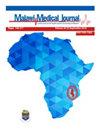是否有可能预测手术部位感染?
IF 0.8
4区 医学
Q4 PUBLIC, ENVIRONMENTAL & OCCUPATIONAL HEALTH
引用次数: 0
摘要
手术部位感染(SSI)是一种常见的术后并发症,会导致生活质量下降和经济负担。在本研究中,我们旨在发现术前和术后中性粒细胞淋巴细胞比率(NLR)和血小板淋巴细胞比率(PLR)值对SSI的预测价值。方法回顾性分析698例经腹式全子宫切除术的良性指征及病理组织学检查结果。本研究探讨术前NLR、术前PLR、术后NLR、术后PLR与术后手术部位感染并发症发生的相关性。结果术后随访30 d, SSI总发生率为9.46% (n = 66)。ssi患者术前NLR、PLR值均显著低于对照组(p <0.05)。ssi患者术后NLR和PLR值显著高于对照组(p <0.05)。术后发生ssi的患者,术后NLR和PLR值的升高均显著高于对照组(p <0.05)。结论在我们的研究中,NLR和PLR的血液学指标被发现是SSI的独立且重要的预测指标。本文章由计算机程序翻译,如有差异,请以英文原文为准。
Is it possible to predict Surgical Site Infection?
IntroductionSurgical site infection (SSI) is a widely seen postoperative complication that causes a decrease in life quality and an economic burden. In this study, we aim to find the predictive values of preoperative and postoperative neutrophile lymphocyte ratio (NLR) and platelet lymphocyte ratio (PLR) values for SSI.MethodsIn this retrospective study, 698 patients who had total abdominal hysterectomy operations with benign indications and confirmed histopathological results were accessed. In this study, the correlation of preoperative NLR, preoperative PLR, postoperative NLR, and postoperative PLR, with the occurrence of postoperative surgical site infection complications were examined. Results The overall SSI rate was 9.46% (n = 66) with 30 days follow-up postoperatively. Preoperative NLR and PLR values of the patients who had SSIs were significantly lower than the control group (p < 0.05). Postoperative NLR and PLR values of the patients who had SSIs were significantly higher than control group (p < 0.05). In the patients who had postoperative SSIs, the increase of the values of postoperative NLR and PLR were significantly higher than the control group (p < 0.05).ConclusionsIn our study, hematological markers of NLR and PLR were found to be independent and significant predictive markers for SSI.
求助全文
通过发布文献求助,成功后即可免费获取论文全文。
去求助
来源期刊

Malawi Medical Journal
Medicine-General Medicine
CiteScore
1.50
自引率
0.00%
发文量
27
审稿时长
>12 weeks
期刊介绍:
Driven and guided by the priorities articulated in the Malawi National Health Research Agenda, the Malawi Medical Journal publishes original research, short reports, case reports, viewpoints, insightful editorials and commentaries that are of high quality, informative and applicable to the Malawian and sub-Saharan Africa regions. Our particular interest is to publish evidence-based research that impacts and informs national health policies and medical practice in Malawi and the broader region.
Topics covered in the journal include, but are not limited to:
- Communicable diseases (HIV and AIDS, Malaria, TB, etc.)
- Non-communicable diseases (Cardiovascular diseases, cancer, diabetes, etc.)
- Sexual and Reproductive Health (Adolescent health, education, pregnancy and abortion, STDs and HIV and AIDS, etc.)
- Mental health
- Environmental health
- Nutrition
- Health systems and health policy (Leadership, ethics, and governance)
- Community systems strengthening research
- Injury, trauma, and surgical disorders
 求助内容:
求助内容: 应助结果提醒方式:
应助结果提醒方式:


